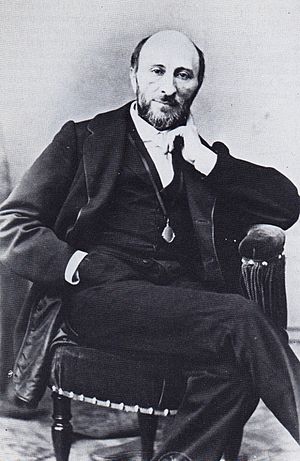Arthur Saint-Léon facts for kids
Arthur Saint-Léon (born September 17, 1821, in Paris – died September 2, 1870) was a very important person in the world of ballet. He was a famous Maître de Ballet (which means "Ballet Master" or main choreographer) for the Imperial Ballet in St. Petersburg, Russia. He held this job from 1859 to 1869. Saint-Léon is most famous for creating the dances for the well-known ballet called Coppélia.
Contents
Arthur Saint-Léon's Life Story
Arthur Saint-Léon was born Charles Victor Arthur Michel in Paris. He grew up in Stuttgart, where his father was a dance teacher for the royal court and the theater. His father, who had also been a dancer with the Paris Opéra Ballet, encouraged Arthur to study both music and dance.
Arthur Saint-Léon learned to play the violin from famous musicians like Joseph Mayseder and Niccolò Paganini. At the same time, he also trained in ballet. This way, he could perform as both a violinist and a dancer!
When he was 17, he made his first big performance as a dancer at the Théâtre de la Monnaie in Brussels. After that, he traveled all over Europe, dancing in countries like Germany, Italy, and England. He became very popular. Even in London, where people at the time didn't usually like to see men dancing on stage, he was a big hit! People loved his tours and his amazing jumps. He was able to get applause in every theater he danced in. This was special during the Romantic Era of ballet, when most of the attention was on the female ballerinas dancing on their toes (en pointe).
In Vienna, Saint-Léon danced for the first time with a famous ballerina named Fanny Cerrito. From that moment on, they were almost always together. They got married in 1845. For Cerrito, Saint-Léon created a ballet called La Vivandière (1843), which was very successful in London. He also created ballets for the Teatro La Fenice in Venice and the Paris Opéra.
He later became a teacher for the main ballet class at the Paris Opéra. He was also in charge of creating the "divertissements" (short, entertaining dances) for the most important ballet shows. He and his wife separated in 1851. When Fanny Cerrito was invited to dance at the Opéra, Saint-Léon decided to retire from dancing there.
After touring more in Europe, he was invited to take over from another famous ballet master, Jules Perrot, in 1859. This new job was as the Maître de Ballet for the Imperial Bolshoi Kamenny Theatre in St. Petersburg, Russia. This theater was home to the Tsar's famous Imperial Ballet. Saint-Léon held this important position until 1869.
His favorite ballerina was Adèle Grantzow. She performed in many of his ballets. Saint-Léon brought her to the Paris Opéra and later to Italy. He even planned to create his famous ballet Coppélia (1870) for her. Even though he choreographed many ballets, Coppélia is the only one that we still have almost completely today. He passed away just two days after Coppélia's first performances ended early because of the Franco-Prussian War. Sadly, the dancer who first played Swanhilda in Coppélia, Giuseppina Bozzacchi, also died shortly after, on her 17th birthday.
Saint-Léon is also famous for inventing a way to write down ballet steps. He described this method in his book, La Sténochoréographie, ou Art d'écrire promptement la danse, published in 1852. It was the first method of writing down choreography that included not only the feet but also the movements of the arms, body, and head.
The La Vivandière Pas de Six
In 1848, Saint-Léon wrote down a specific dance called a Pas de Six from his 1846 ballet La Vivandière. He used his special notation system, La Sténochorégraphie. This written dance was kept safe in the archives of the Paris Opéra.
In 1975, a dance notation expert named Ann Hutchinson-Guest and a Balletmaster named Pierre Lacotte used Saint-Léon's notes to bring the dance back to life. They recreated Saint-Léon's choreography and Cesare Pugni's music for the Joffrey Ballet. In 1978, Lacotte staged the Pas de Six for the Kirov/Mariinsky Ballet (which used to be the Imperial Ballet). They still perform it today!
The Pas de Six has since been performed by many ballet companies around the world. It is known as either the La Vivandière Pas de Six or the Markitenka Pas de Six (in Russia). This Pas de Six is the only known choreography by Saint-Léon that has survived to our time.
Main Ballets Created by Arthur Saint-Léon
Here are some of the main ballets that Arthur Saint-Léon choreographed (created the dances for):
- 1843 La Vivandière (music by Cesare Pugni)
- 1847 La Fille de marbre (music by Cesare Pugni, based on an earlier ballet)
- 1849 Le Violon du Diable (music by Cesare Pugni). For this ballet, Saint-Léon performed as both a dancer and a violinist!
- 1850 Stella (music by Cesare Pugni)
- 1860 Graziella ou La Querelle amoureuse (music by Cesare Pugni)
- 1861 La Perle de Seville (music by Cesare Pugni)
- 1864 Fiametta (music by Ludwig Minkus)
- 1864 The Little Humpbacked Horse (music by Cesare Pugni)
- 1866 Le Poisson doré (music by Ludwig Minkus)
- 1866 La Source (music by Ludwig Minkus and Léo Delibes)
- 1869 Le Lys (music by Ludwig Minkus). For this ballet, Minkus reused a lot of the music he wrote for La Source.
- 1870 Coppélia (music by L. Delibes)
See also
 In Spanish: Arthur Saint-Léon para niños
In Spanish: Arthur Saint-Léon para niños
- Luigi Astolfi


